Service Quality and Staff Behavior in Tourism, Hospitality & Events
VerifiedAdded on 2023/01/19
|19
|4744
|48
Report
AI Summary
This report delves into the evaluation of service quality within the international tourism, hospitality, and event management industries. It explores the application and analysis of quality management tools, specifically focusing on Six Sigma and Just-In-Time (JIT) methodologies. The report critically evaluates the use of these tools, providing examples of their implementation in the industry and identifying both benefits and drawbacks. It draws upon academic journals and literature to understand how these techniques influence staff behavior, citing contemporary examples. The analysis extends to identifying areas for improvement to increase employee satisfaction and enhance the overall quality of service, offering insights into how businesses can optimize their operations and maintain a competitive edge. The report examines the impact of changing consumer preferences, industrialization, and other factors on the industry, highlighting the importance of service quality in achieving customer satisfaction and loyalty.
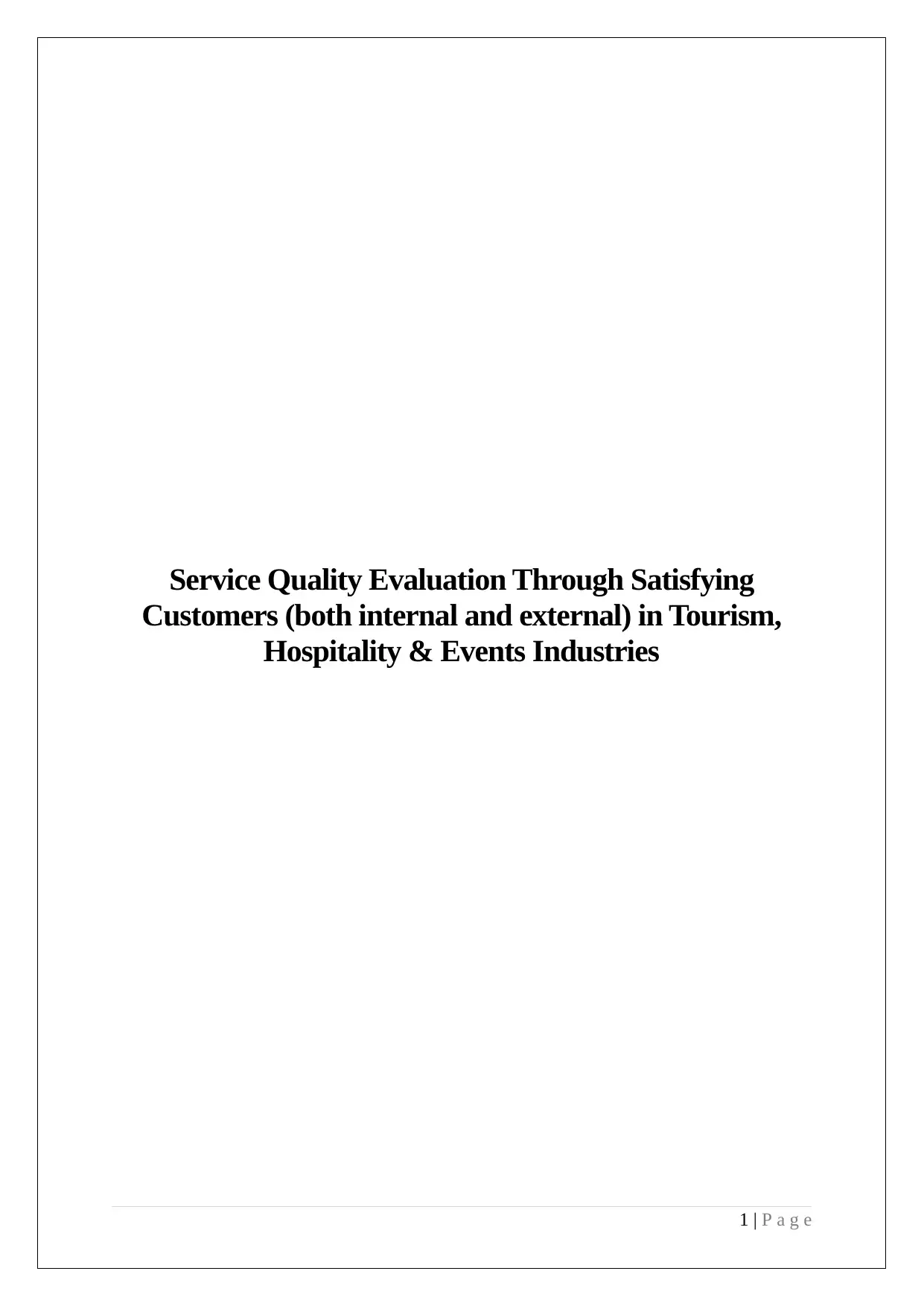
Service Quality Evaluation Through Satisfying
Customers (both internal and external) in Tourism,
Hospitality & Events Industries
1 | P a g e
Customers (both internal and external) in Tourism,
Hospitality & Events Industries
1 | P a g e
Paraphrase This Document
Need a fresh take? Get an instant paraphrase of this document with our AI Paraphraser
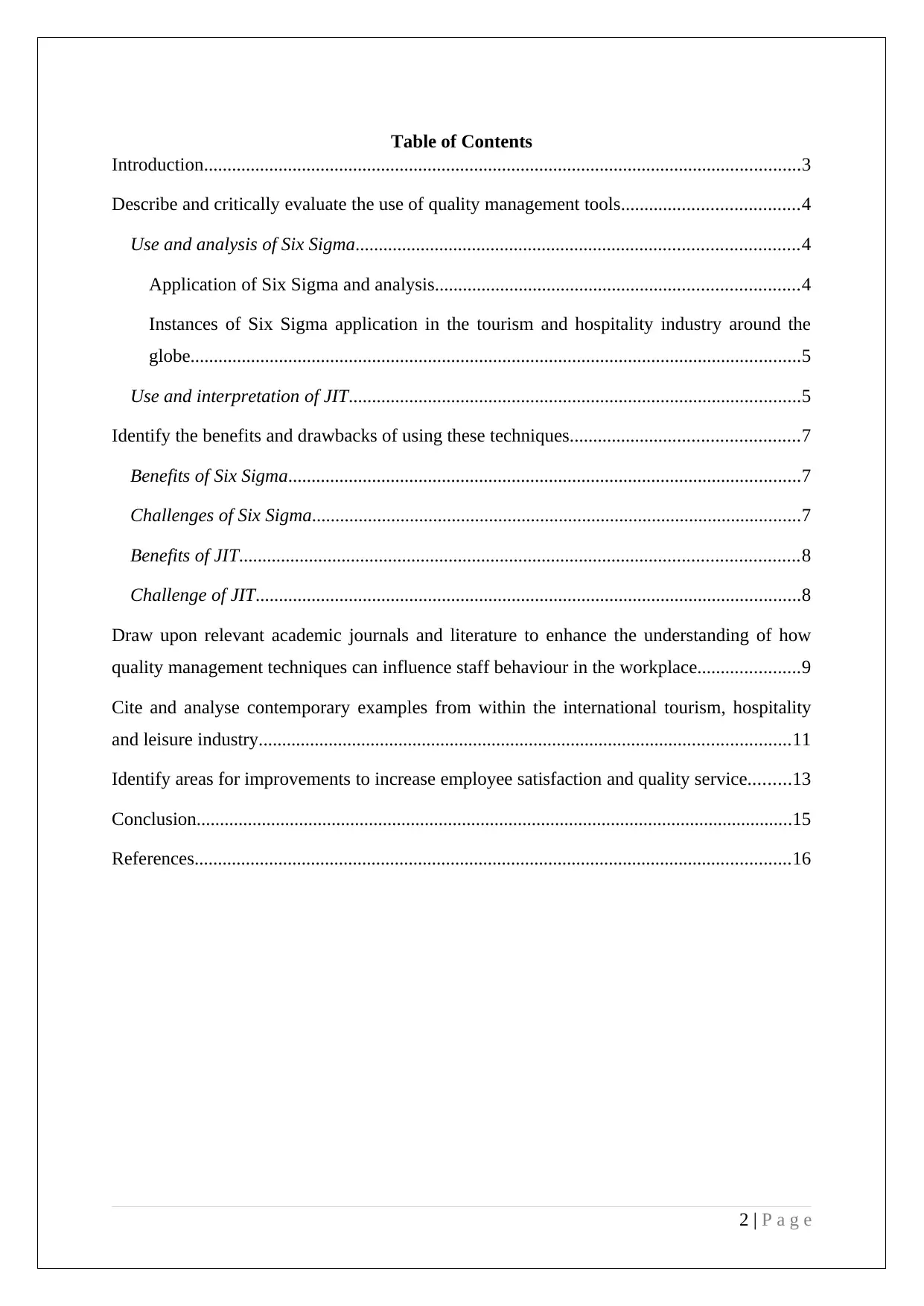
Table of Contents
Introduction................................................................................................................................3
Describe and critically evaluate the use of quality management tools......................................4
Use and analysis of Six Sigma...............................................................................................4
Application of Six Sigma and analysis..............................................................................4
Instances of Six Sigma application in the tourism and hospitality industry around the
globe...................................................................................................................................5
Use and interpretation of JIT.................................................................................................5
Identify the benefits and drawbacks of using these techniques.................................................7
Benefits of Six Sigma..............................................................................................................7
Challenges of Six Sigma.........................................................................................................7
Benefits of JIT........................................................................................................................8
Challenge of JIT.....................................................................................................................8
Draw upon relevant academic journals and literature to enhance the understanding of how
quality management techniques can influence staff behaviour in the workplace......................9
Cite and analyse contemporary examples from within the international tourism, hospitality
and leisure industry..................................................................................................................11
Identify areas for improvements to increase employee satisfaction and quality service.........13
Conclusion................................................................................................................................15
References................................................................................................................................16
2 | P a g e
Introduction................................................................................................................................3
Describe and critically evaluate the use of quality management tools......................................4
Use and analysis of Six Sigma...............................................................................................4
Application of Six Sigma and analysis..............................................................................4
Instances of Six Sigma application in the tourism and hospitality industry around the
globe...................................................................................................................................5
Use and interpretation of JIT.................................................................................................5
Identify the benefits and drawbacks of using these techniques.................................................7
Benefits of Six Sigma..............................................................................................................7
Challenges of Six Sigma.........................................................................................................7
Benefits of JIT........................................................................................................................8
Challenge of JIT.....................................................................................................................8
Draw upon relevant academic journals and literature to enhance the understanding of how
quality management techniques can influence staff behaviour in the workplace......................9
Cite and analyse contemporary examples from within the international tourism, hospitality
and leisure industry..................................................................................................................11
Identify areas for improvements to increase employee satisfaction and quality service.........13
Conclusion................................................................................................................................15
References................................................................................................................................16
2 | P a g e
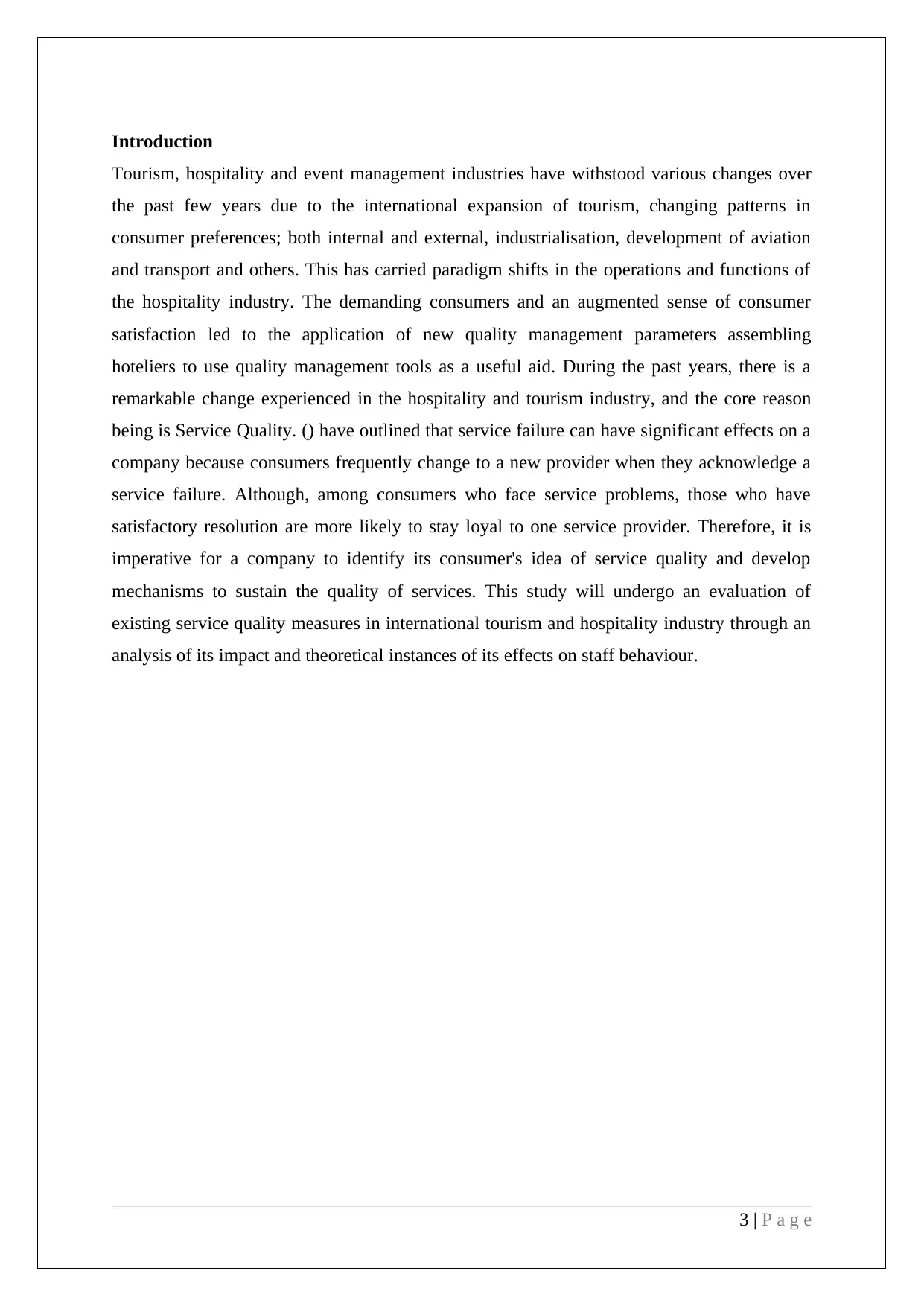
Introduction
Tourism, hospitality and event management industries have withstood various changes over
the past few years due to the international expansion of tourism, changing patterns in
consumer preferences; both internal and external, industrialisation, development of aviation
and transport and others. This has carried paradigm shifts in the operations and functions of
the hospitality industry. The demanding consumers and an augmented sense of consumer
satisfaction led to the application of new quality management parameters assembling
hoteliers to use quality management tools as a useful aid. During the past years, there is a
remarkable change experienced in the hospitality and tourism industry, and the core reason
being is Service Quality. () have outlined that service failure can have significant effects on a
company because consumers frequently change to a new provider when they acknowledge a
service failure. Although, among consumers who face service problems, those who have
satisfactory resolution are more likely to stay loyal to one service provider. Therefore, it is
imperative for a company to identify its consumer's idea of service quality and develop
mechanisms to sustain the quality of services. This study will undergo an evaluation of
existing service quality measures in international tourism and hospitality industry through an
analysis of its impact and theoretical instances of its effects on staff behaviour.
3 | P a g e
Tourism, hospitality and event management industries have withstood various changes over
the past few years due to the international expansion of tourism, changing patterns in
consumer preferences; both internal and external, industrialisation, development of aviation
and transport and others. This has carried paradigm shifts in the operations and functions of
the hospitality industry. The demanding consumers and an augmented sense of consumer
satisfaction led to the application of new quality management parameters assembling
hoteliers to use quality management tools as a useful aid. During the past years, there is a
remarkable change experienced in the hospitality and tourism industry, and the core reason
being is Service Quality. () have outlined that service failure can have significant effects on a
company because consumers frequently change to a new provider when they acknowledge a
service failure. Although, among consumers who face service problems, those who have
satisfactory resolution are more likely to stay loyal to one service provider. Therefore, it is
imperative for a company to identify its consumer's idea of service quality and develop
mechanisms to sustain the quality of services. This study will undergo an evaluation of
existing service quality measures in international tourism and hospitality industry through an
analysis of its impact and theoretical instances of its effects on staff behaviour.
3 | P a g e
⊘ This is a preview!⊘
Do you want full access?
Subscribe today to unlock all pages.

Trusted by 1+ million students worldwide
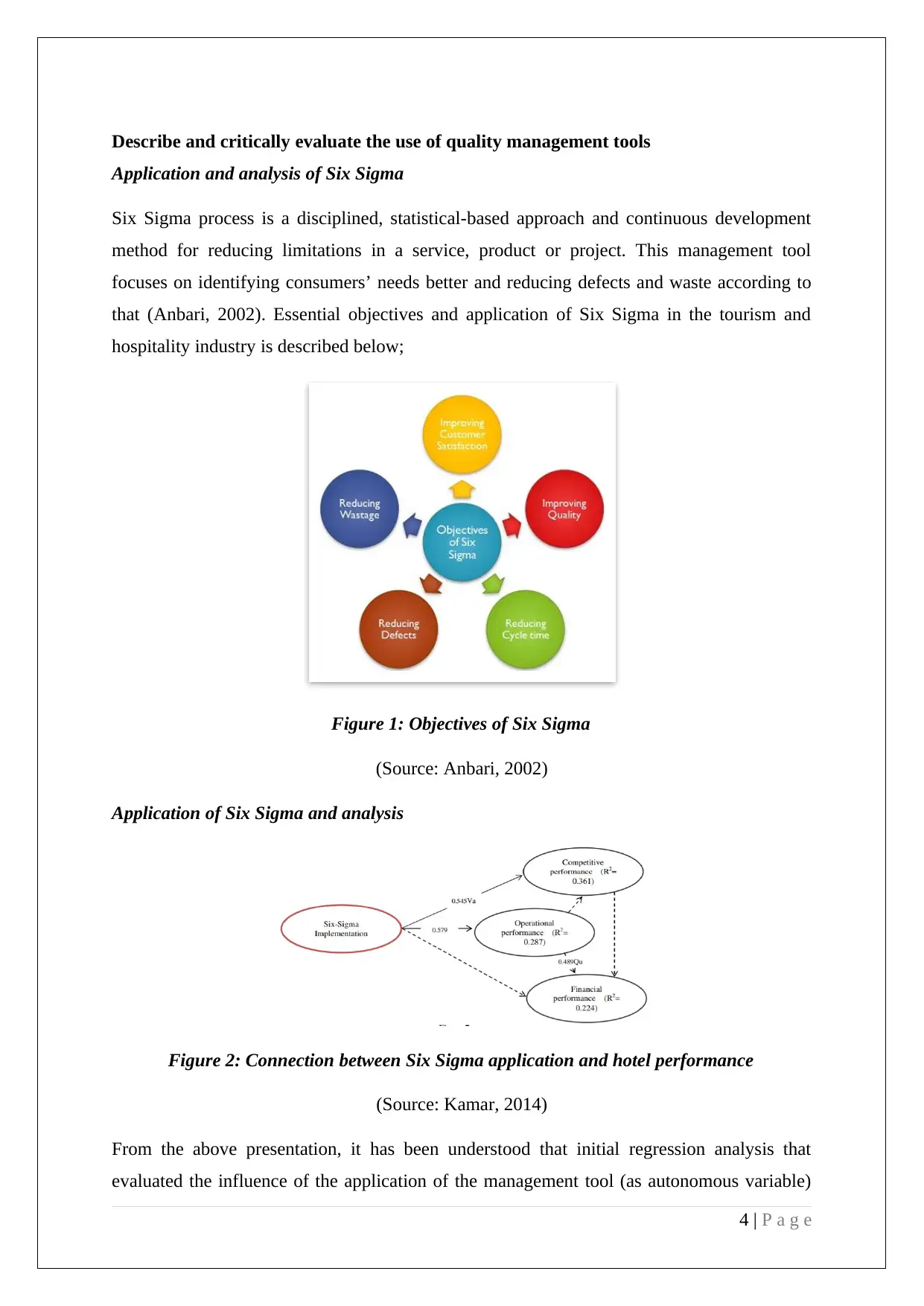
Describe and critically evaluate the use of quality management tools
Application and analysis of Six Sigma
Six Sigma process is a disciplined, statistical-based approach and continuous development
method for reducing limitations in a service, product or project. This management tool
focuses on identifying consumers’ needs better and reducing defects and waste according to
that (Anbari, 2002). Essential objectives and application of Six Sigma in the tourism and
hospitality industry is described below;
Figure 1: Objectives of Six Sigma
(Source: Anbari, 2002)
Application of Six Sigma and analysis
Figure 2: Connection between Six Sigma application and hotel performance
(Source: Kamar, 2014)
From the above presentation, it has been understood that initial regression analysis that
evaluated the influence of the application of the management tool (as autonomous variable)
4 | P a g e
Application and analysis of Six Sigma
Six Sigma process is a disciplined, statistical-based approach and continuous development
method for reducing limitations in a service, product or project. This management tool
focuses on identifying consumers’ needs better and reducing defects and waste according to
that (Anbari, 2002). Essential objectives and application of Six Sigma in the tourism and
hospitality industry is described below;
Figure 1: Objectives of Six Sigma
(Source: Anbari, 2002)
Application of Six Sigma and analysis
Figure 2: Connection between Six Sigma application and hotel performance
(Source: Kamar, 2014)
From the above presentation, it has been understood that initial regression analysis that
evaluated the influence of the application of the management tool (as autonomous variable)
4 | P a g e
Paraphrase This Document
Need a fresh take? Get an instant paraphrase of this document with our AI Paraphraser
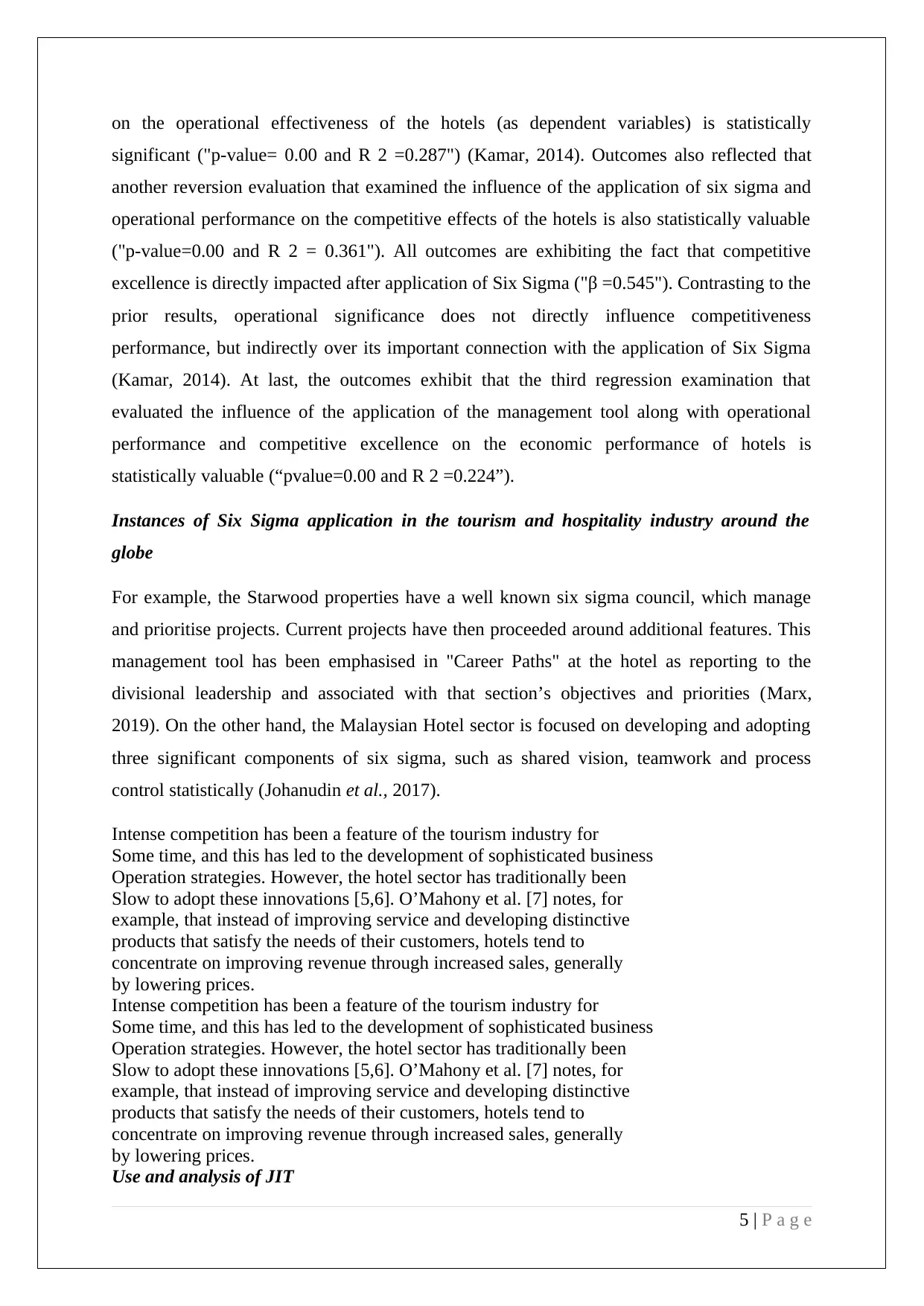
on the operational effectiveness of the hotels (as dependent variables) is statistically
significant ("p-value= 0.00 and R 2 =0.287") (Kamar, 2014). Outcomes also reflected that
another reversion evaluation that examined the influence of the application of six sigma and
operational performance on the competitive effects of the hotels is also statistically valuable
("p-value=0.00 and R 2 = 0.361"). All outcomes are exhibiting the fact that competitive
excellence is directly impacted after application of Six Sigma ("β =0.545"). Contrasting to the
prior results, operational significance does not directly influence competitiveness
performance, but indirectly over its important connection with the application of Six Sigma
(Kamar, 2014). At last, the outcomes exhibit that the third regression examination that
evaluated the influence of the application of the management tool along with operational
performance and competitive excellence on the economic performance of hotels is
statistically valuable (“pvalue=0.00 and R 2 =0.224”).
Instances of Six Sigma application in the tourism and hospitality industry around the
globe
For example, the Starwood properties have a well known six sigma council, which manage
and prioritise projects. Current projects have then proceeded around additional features. This
management tool has been emphasised in "Career Paths" at the hotel as reporting to the
divisional leadership and associated with that section’s objectives and priorities (Marx,
2019). On the other hand, the Malaysian Hotel sector is focused on developing and adopting
three significant components of six sigma, such as shared vision, teamwork and process
control statistically (Johanudin et al., 2017).
Intense competition has been a feature of the tourism industry for
Some time, and this has led to the development of sophisticated business
Operation strategies. However, the hotel sector has traditionally been
Slow to adopt these innovations [5,6]. O’Mahony et al. [7] notes, for
example, that instead of improving service and developing distinctive
products that satisfy the needs of their customers, hotels tend to
concentrate on improving revenue through increased sales, generally
by lowering prices.
Intense competition has been a feature of the tourism industry for
Some time, and this has led to the development of sophisticated business
Operation strategies. However, the hotel sector has traditionally been
Slow to adopt these innovations [5,6]. O’Mahony et al. [7] notes, for
example, that instead of improving service and developing distinctive
products that satisfy the needs of their customers, hotels tend to
concentrate on improving revenue through increased sales, generally
by lowering prices.
Use and analysis of JIT
5 | P a g e
significant ("p-value= 0.00 and R 2 =0.287") (Kamar, 2014). Outcomes also reflected that
another reversion evaluation that examined the influence of the application of six sigma and
operational performance on the competitive effects of the hotels is also statistically valuable
("p-value=0.00 and R 2 = 0.361"). All outcomes are exhibiting the fact that competitive
excellence is directly impacted after application of Six Sigma ("β =0.545"). Contrasting to the
prior results, operational significance does not directly influence competitiveness
performance, but indirectly over its important connection with the application of Six Sigma
(Kamar, 2014). At last, the outcomes exhibit that the third regression examination that
evaluated the influence of the application of the management tool along with operational
performance and competitive excellence on the economic performance of hotels is
statistically valuable (“pvalue=0.00 and R 2 =0.224”).
Instances of Six Sigma application in the tourism and hospitality industry around the
globe
For example, the Starwood properties have a well known six sigma council, which manage
and prioritise projects. Current projects have then proceeded around additional features. This
management tool has been emphasised in "Career Paths" at the hotel as reporting to the
divisional leadership and associated with that section’s objectives and priorities (Marx,
2019). On the other hand, the Malaysian Hotel sector is focused on developing and adopting
three significant components of six sigma, such as shared vision, teamwork and process
control statistically (Johanudin et al., 2017).
Intense competition has been a feature of the tourism industry for
Some time, and this has led to the development of sophisticated business
Operation strategies. However, the hotel sector has traditionally been
Slow to adopt these innovations [5,6]. O’Mahony et al. [7] notes, for
example, that instead of improving service and developing distinctive
products that satisfy the needs of their customers, hotels tend to
concentrate on improving revenue through increased sales, generally
by lowering prices.
Intense competition has been a feature of the tourism industry for
Some time, and this has led to the development of sophisticated business
Operation strategies. However, the hotel sector has traditionally been
Slow to adopt these innovations [5,6]. O’Mahony et al. [7] notes, for
example, that instead of improving service and developing distinctive
products that satisfy the needs of their customers, hotels tend to
concentrate on improving revenue through increased sales, generally
by lowering prices.
Use and analysis of JIT
5 | P a g e
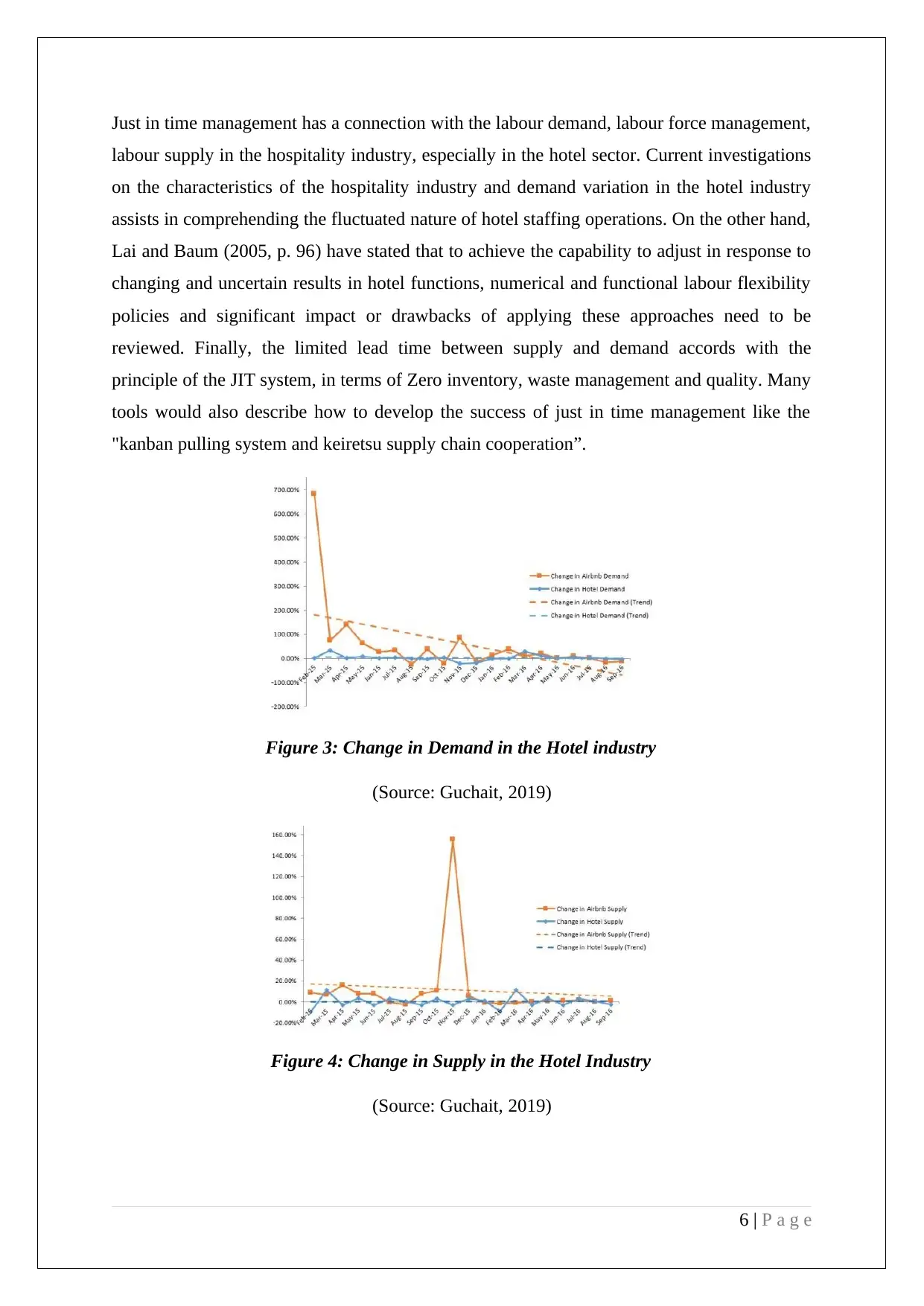
Just in time management has a connection with the labour demand, labour force management,
labour supply in the hospitality industry, especially in the hotel sector. Current investigations
on the characteristics of the hospitality industry and demand variation in the hotel industry
assists in comprehending the fluctuated nature of hotel staffing operations. On the other hand,
Lai and Baum (2005, p. 96) have stated that to achieve the capability to adjust in response to
changing and uncertain results in hotel functions, numerical and functional labour flexibility
policies and significant impact or drawbacks of applying these approaches need to be
reviewed. Finally, the limited lead time between supply and demand accords with the
principle of the JIT system, in terms of Zero inventory, waste management and quality. Many
tools would also describe how to develop the success of just in time management like the
"kanban pulling system and keiretsu supply chain cooperation”.
Figure 3: Change in Demand in the Hotel industry
(Source: Guchait, 2019)
Figure 4: Change in Supply in the Hotel Industry
(Source: Guchait, 2019)
6 | P a g e
labour supply in the hospitality industry, especially in the hotel sector. Current investigations
on the characteristics of the hospitality industry and demand variation in the hotel industry
assists in comprehending the fluctuated nature of hotel staffing operations. On the other hand,
Lai and Baum (2005, p. 96) have stated that to achieve the capability to adjust in response to
changing and uncertain results in hotel functions, numerical and functional labour flexibility
policies and significant impact or drawbacks of applying these approaches need to be
reviewed. Finally, the limited lead time between supply and demand accords with the
principle of the JIT system, in terms of Zero inventory, waste management and quality. Many
tools would also describe how to develop the success of just in time management like the
"kanban pulling system and keiretsu supply chain cooperation”.
Figure 3: Change in Demand in the Hotel industry
(Source: Guchait, 2019)
Figure 4: Change in Supply in the Hotel Industry
(Source: Guchait, 2019)
6 | P a g e
⊘ This is a preview!⊘
Do you want full access?
Subscribe today to unlock all pages.

Trusted by 1+ million students worldwide
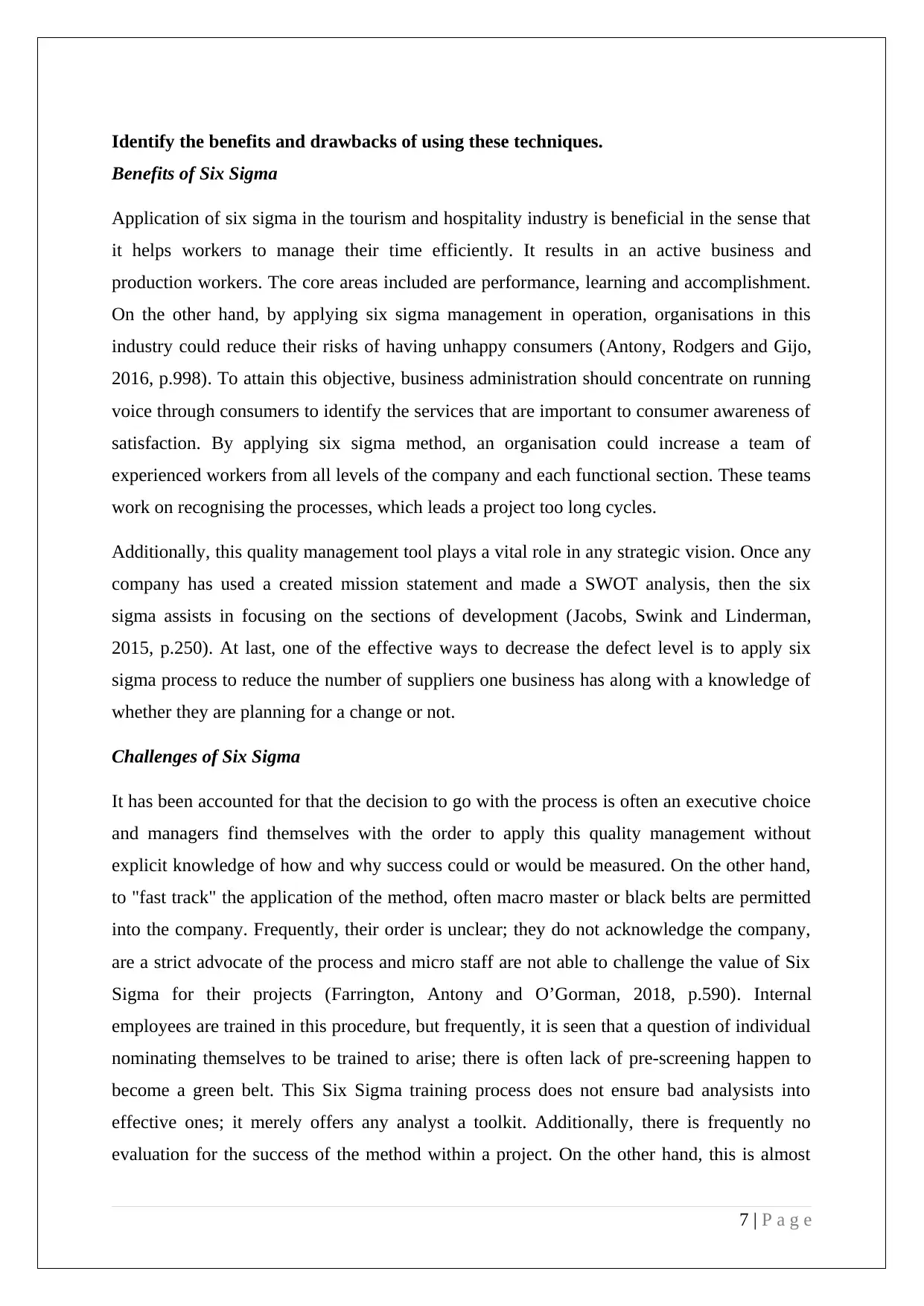
Identify the benefits and drawbacks of using these techniques.
Benefits of Six Sigma
Application of six sigma in the tourism and hospitality industry is beneficial in the sense that
it helps workers to manage their time efficiently. It results in an active business and
production workers. The core areas included are performance, learning and accomplishment.
On the other hand, by applying six sigma management in operation, organisations in this
industry could reduce their risks of having unhappy consumers (Antony, Rodgers and Gijo,
2016, p.998). To attain this objective, business administration should concentrate on running
voice through consumers to identify the services that are important to consumer awareness of
satisfaction. By applying six sigma method, an organisation could increase a team of
experienced workers from all levels of the company and each functional section. These teams
work on recognising the processes, which leads a project too long cycles.
Additionally, this quality management tool plays a vital role in any strategic vision. Once any
company has used a created mission statement and made a SWOT analysis, then the six
sigma assists in focusing on the sections of development (Jacobs, Swink and Linderman,
2015, p.250). At last, one of the effective ways to decrease the defect level is to apply six
sigma process to reduce the number of suppliers one business has along with a knowledge of
whether they are planning for a change or not.
Challenges of Six Sigma
It has been accounted for that the decision to go with the process is often an executive choice
and managers find themselves with the order to apply this quality management without
explicit knowledge of how and why success could or would be measured. On the other hand,
to "fast track" the application of the method, often macro master or black belts are permitted
into the company. Frequently, their order is unclear; they do not acknowledge the company,
are a strict advocate of the process and micro staff are not able to challenge the value of Six
Sigma for their projects (Farrington, Antony and O’Gorman, 2018, p.590). Internal
employees are trained in this procedure, but frequently, it is seen that a question of individual
nominating themselves to be trained to arise; there is often lack of pre-screening happen to
become a green belt. This Six Sigma training process does not ensure bad analysists into
effective ones; it merely offers any analyst a toolkit. Additionally, there is frequently no
evaluation for the success of the method within a project. On the other hand, this is almost
7 | P a g e
Benefits of Six Sigma
Application of six sigma in the tourism and hospitality industry is beneficial in the sense that
it helps workers to manage their time efficiently. It results in an active business and
production workers. The core areas included are performance, learning and accomplishment.
On the other hand, by applying six sigma management in operation, organisations in this
industry could reduce their risks of having unhappy consumers (Antony, Rodgers and Gijo,
2016, p.998). To attain this objective, business administration should concentrate on running
voice through consumers to identify the services that are important to consumer awareness of
satisfaction. By applying six sigma method, an organisation could increase a team of
experienced workers from all levels of the company and each functional section. These teams
work on recognising the processes, which leads a project too long cycles.
Additionally, this quality management tool plays a vital role in any strategic vision. Once any
company has used a created mission statement and made a SWOT analysis, then the six
sigma assists in focusing on the sections of development (Jacobs, Swink and Linderman,
2015, p.250). At last, one of the effective ways to decrease the defect level is to apply six
sigma process to reduce the number of suppliers one business has along with a knowledge of
whether they are planning for a change or not.
Challenges of Six Sigma
It has been accounted for that the decision to go with the process is often an executive choice
and managers find themselves with the order to apply this quality management without
explicit knowledge of how and why success could or would be measured. On the other hand,
to "fast track" the application of the method, often macro master or black belts are permitted
into the company. Frequently, their order is unclear; they do not acknowledge the company,
are a strict advocate of the process and micro staff are not able to challenge the value of Six
Sigma for their projects (Farrington, Antony and O’Gorman, 2018, p.590). Internal
employees are trained in this procedure, but frequently, it is seen that a question of individual
nominating themselves to be trained to arise; there is often lack of pre-screening happen to
become a green belt. This Six Sigma training process does not ensure bad analysists into
effective ones; it merely offers any analyst a toolkit. Additionally, there is frequently no
evaluation for the success of the method within a project. On the other hand, this is almost
7 | P a g e
Paraphrase This Document
Need a fresh take? Get an instant paraphrase of this document with our AI Paraphraser
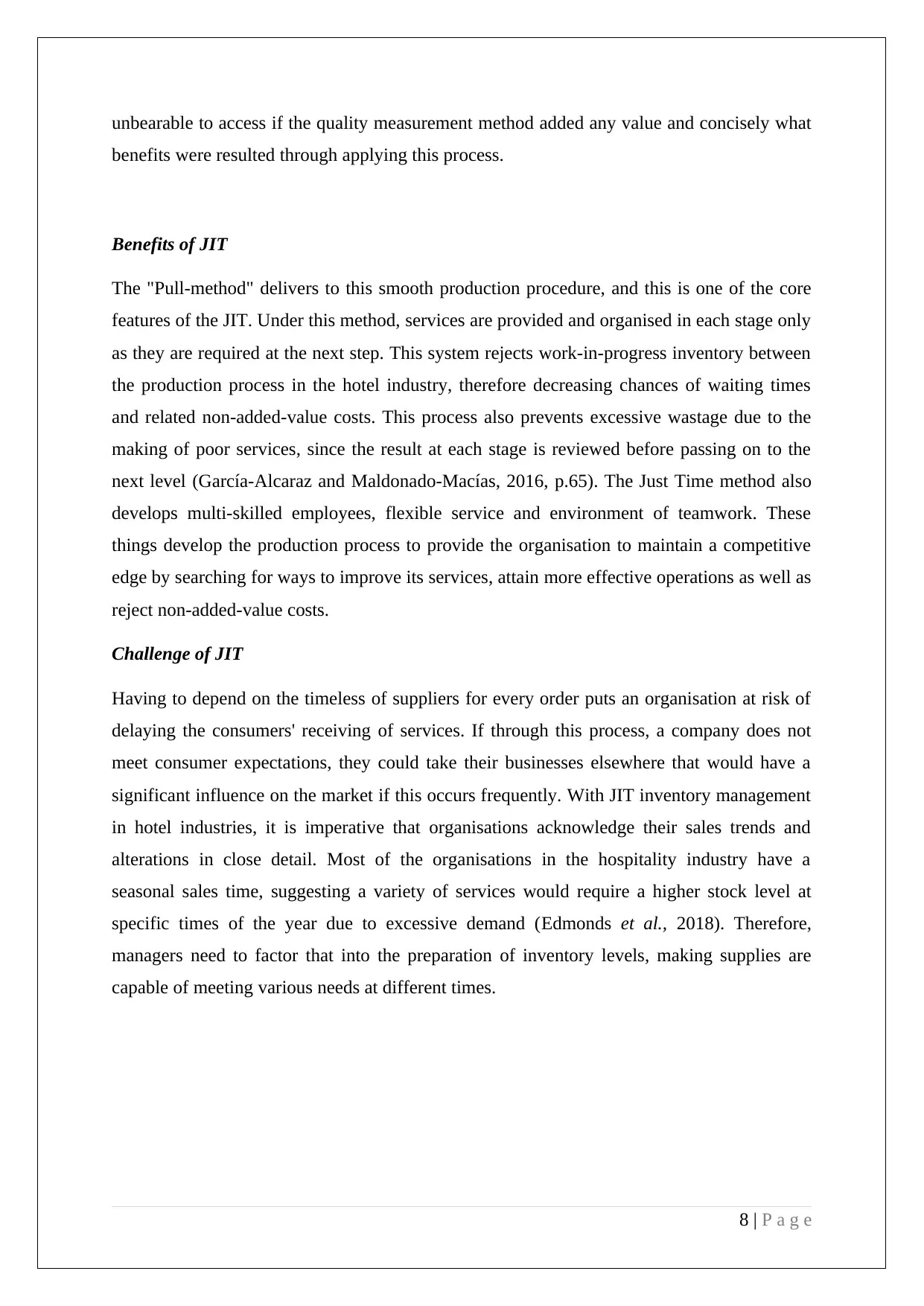
unbearable to access if the quality measurement method added any value and concisely what
benefits were resulted through applying this process.
Benefits of JIT
The "Pull-method" delivers to this smooth production procedure, and this is one of the core
features of the JIT. Under this method, services are provided and organised in each stage only
as they are required at the next step. This system rejects work-in-progress inventory between
the production process in the hotel industry, therefore decreasing chances of waiting times
and related non-added-value costs. This process also prevents excessive wastage due to the
making of poor services, since the result at each stage is reviewed before passing on to the
next level (García-Alcaraz and Maldonado-Macías, 2016, p.65). The Just Time method also
develops multi-skilled employees, flexible service and environment of teamwork. These
things develop the production process to provide the organisation to maintain a competitive
edge by searching for ways to improve its services, attain more effective operations as well as
reject non-added-value costs.
Challenge of JIT
Having to depend on the timeless of suppliers for every order puts an organisation at risk of
delaying the consumers' receiving of services. If through this process, a company does not
meet consumer expectations, they could take their businesses elsewhere that would have a
significant influence on the market if this occurs frequently. With JIT inventory management
in hotel industries, it is imperative that organisations acknowledge their sales trends and
alterations in close detail. Most of the organisations in the hospitality industry have a
seasonal sales time, suggesting a variety of services would require a higher stock level at
specific times of the year due to excessive demand (Edmonds et al., 2018). Therefore,
managers need to factor that into the preparation of inventory levels, making supplies are
capable of meeting various needs at different times.
8 | P a g e
benefits were resulted through applying this process.
Benefits of JIT
The "Pull-method" delivers to this smooth production procedure, and this is one of the core
features of the JIT. Under this method, services are provided and organised in each stage only
as they are required at the next step. This system rejects work-in-progress inventory between
the production process in the hotel industry, therefore decreasing chances of waiting times
and related non-added-value costs. This process also prevents excessive wastage due to the
making of poor services, since the result at each stage is reviewed before passing on to the
next level (García-Alcaraz and Maldonado-Macías, 2016, p.65). The Just Time method also
develops multi-skilled employees, flexible service and environment of teamwork. These
things develop the production process to provide the organisation to maintain a competitive
edge by searching for ways to improve its services, attain more effective operations as well as
reject non-added-value costs.
Challenge of JIT
Having to depend on the timeless of suppliers for every order puts an organisation at risk of
delaying the consumers' receiving of services. If through this process, a company does not
meet consumer expectations, they could take their businesses elsewhere that would have a
significant influence on the market if this occurs frequently. With JIT inventory management
in hotel industries, it is imperative that organisations acknowledge their sales trends and
alterations in close detail. Most of the organisations in the hospitality industry have a
seasonal sales time, suggesting a variety of services would require a higher stock level at
specific times of the year due to excessive demand (Edmonds et al., 2018). Therefore,
managers need to factor that into the preparation of inventory levels, making supplies are
capable of meeting various needs at different times.
8 | P a g e
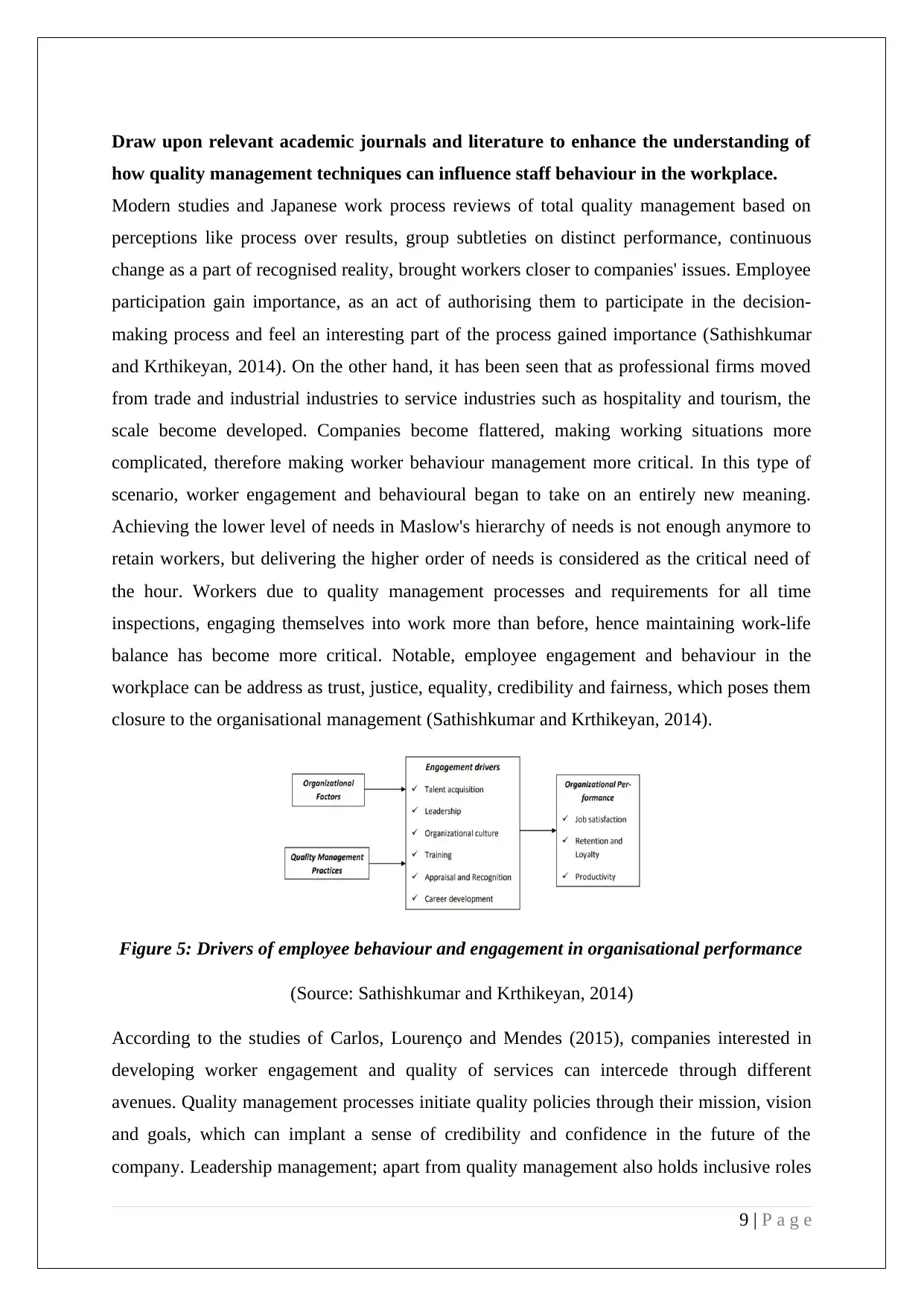
Draw upon relevant academic journals and literature to enhance the understanding of
how quality management techniques can influence staff behaviour in the workplace.
Modern studies and Japanese work process reviews of total quality management based on
perceptions like process over results, group subtleties on distinct performance, continuous
change as a part of recognised reality, brought workers closer to companies' issues. Employee
participation gain importance, as an act of authorising them to participate in the decision-
making process and feel an interesting part of the process gained importance (Sathishkumar
and Krthikeyan, 2014). On the other hand, it has been seen that as professional firms moved
from trade and industrial industries to service industries such as hospitality and tourism, the
scale become developed. Companies become flattered, making working situations more
complicated, therefore making worker behaviour management more critical. In this type of
scenario, worker engagement and behavioural began to take on an entirely new meaning.
Achieving the lower level of needs in Maslow's hierarchy of needs is not enough anymore to
retain workers, but delivering the higher order of needs is considered as the critical need of
the hour. Workers due to quality management processes and requirements for all time
inspections, engaging themselves into work more than before, hence maintaining work-life
balance has become more critical. Notable, employee engagement and behaviour in the
workplace can be address as trust, justice, equality, credibility and fairness, which poses them
closure to the organisational management (Sathishkumar and Krthikeyan, 2014).
Figure 5: Drivers of employee behaviour and engagement in organisational performance
(Source: Sathishkumar and Krthikeyan, 2014)
According to the studies of Carlos, Lourenço and Mendes (2015), companies interested in
developing worker engagement and quality of services can intercede through different
avenues. Quality management processes initiate quality policies through their mission, vision
and goals, which can implant a sense of credibility and confidence in the future of the
company. Leadership management; apart from quality management also holds inclusive roles
9 | P a g e
how quality management techniques can influence staff behaviour in the workplace.
Modern studies and Japanese work process reviews of total quality management based on
perceptions like process over results, group subtleties on distinct performance, continuous
change as a part of recognised reality, brought workers closer to companies' issues. Employee
participation gain importance, as an act of authorising them to participate in the decision-
making process and feel an interesting part of the process gained importance (Sathishkumar
and Krthikeyan, 2014). On the other hand, it has been seen that as professional firms moved
from trade and industrial industries to service industries such as hospitality and tourism, the
scale become developed. Companies become flattered, making working situations more
complicated, therefore making worker behaviour management more critical. In this type of
scenario, worker engagement and behavioural began to take on an entirely new meaning.
Achieving the lower level of needs in Maslow's hierarchy of needs is not enough anymore to
retain workers, but delivering the higher order of needs is considered as the critical need of
the hour. Workers due to quality management processes and requirements for all time
inspections, engaging themselves into work more than before, hence maintaining work-life
balance has become more critical. Notable, employee engagement and behaviour in the
workplace can be address as trust, justice, equality, credibility and fairness, which poses them
closure to the organisational management (Sathishkumar and Krthikeyan, 2014).
Figure 5: Drivers of employee behaviour and engagement in organisational performance
(Source: Sathishkumar and Krthikeyan, 2014)
According to the studies of Carlos, Lourenço and Mendes (2015), companies interested in
developing worker engagement and quality of services can intercede through different
avenues. Quality management processes initiate quality policies through their mission, vision
and goals, which can implant a sense of credibility and confidence in the future of the
company. Leadership management; apart from quality management also holds inclusive roles
9 | P a g e
⊘ This is a preview!⊘
Do you want full access?
Subscribe today to unlock all pages.

Trusted by 1+ million students worldwide
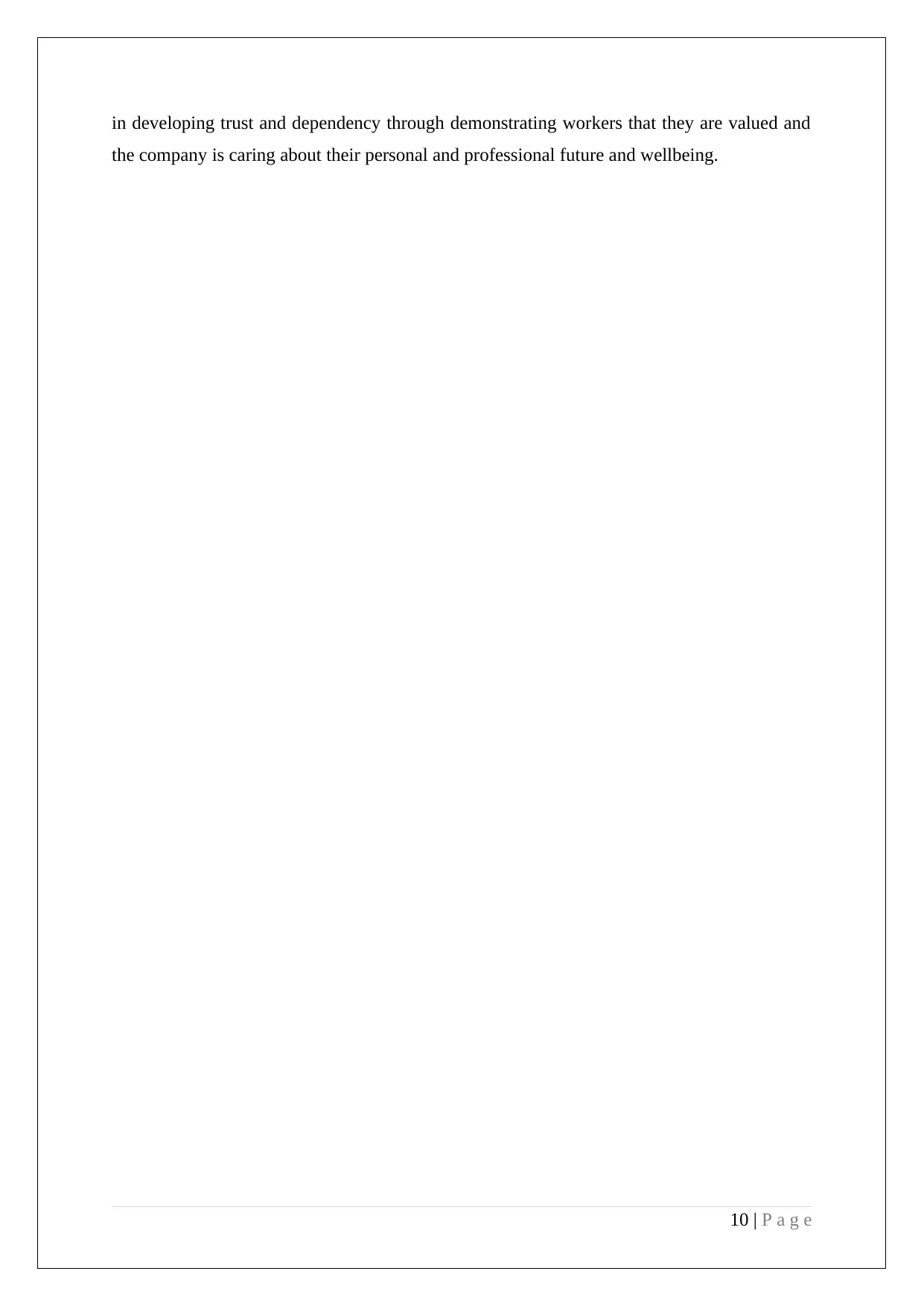
in developing trust and dependency through demonstrating workers that they are valued and
the company is caring about their personal and professional future and wellbeing.
10 | P a g e
the company is caring about their personal and professional future and wellbeing.
10 | P a g e
Paraphrase This Document
Need a fresh take? Get an instant paraphrase of this document with our AI Paraphraser
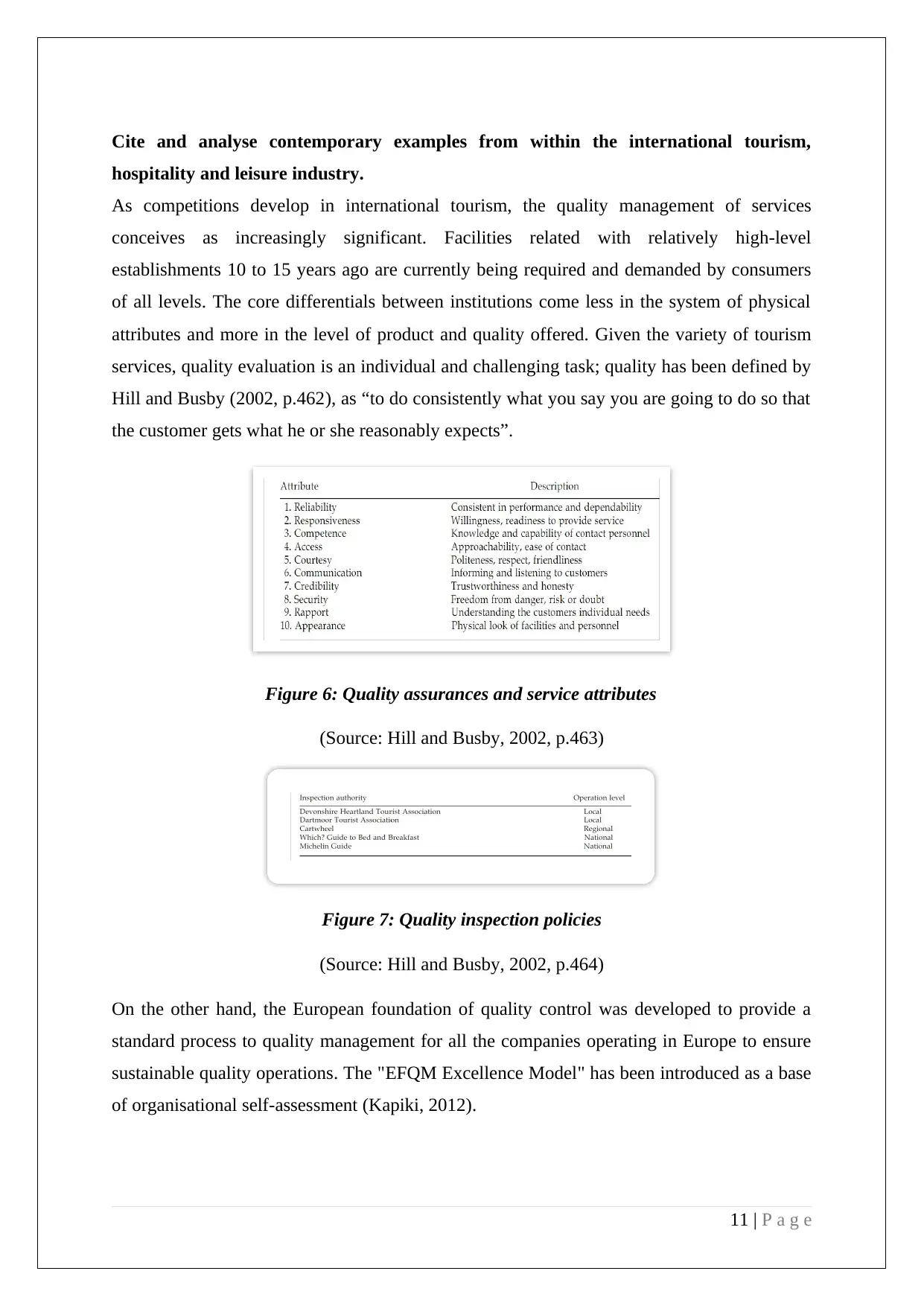
Cite and analyse contemporary examples from within the international tourism,
hospitality and leisure industry.
As competitions develop in international tourism, the quality management of services
conceives as increasingly significant. Facilities related with relatively high-level
establishments 10 to 15 years ago are currently being required and demanded by consumers
of all levels. The core differentials between institutions come less in the system of physical
attributes and more in the level of product and quality offered. Given the variety of tourism
services, quality evaluation is an individual and challenging task; quality has been defined by
Hill and Busby (2002, p.462), as “to do consistently what you say you are going to do so that
the customer gets what he or she reasonably expects”.
Figure 6: Quality assurances and service attributes
(Source: Hill and Busby, 2002, p.463)
Figure 7: Quality inspection policies
(Source: Hill and Busby, 2002, p.464)
On the other hand, the European foundation of quality control was developed to provide a
standard process to quality management for all the companies operating in Europe to ensure
sustainable quality operations. The "EFQM Excellence Model" has been introduced as a base
of organisational self-assessment (Kapiki, 2012).
11 | P a g e
hospitality and leisure industry.
As competitions develop in international tourism, the quality management of services
conceives as increasingly significant. Facilities related with relatively high-level
establishments 10 to 15 years ago are currently being required and demanded by consumers
of all levels. The core differentials between institutions come less in the system of physical
attributes and more in the level of product and quality offered. Given the variety of tourism
services, quality evaluation is an individual and challenging task; quality has been defined by
Hill and Busby (2002, p.462), as “to do consistently what you say you are going to do so that
the customer gets what he or she reasonably expects”.
Figure 6: Quality assurances and service attributes
(Source: Hill and Busby, 2002, p.463)
Figure 7: Quality inspection policies
(Source: Hill and Busby, 2002, p.464)
On the other hand, the European foundation of quality control was developed to provide a
standard process to quality management for all the companies operating in Europe to ensure
sustainable quality operations. The "EFQM Excellence Model" has been introduced as a base
of organisational self-assessment (Kapiki, 2012).
11 | P a g e
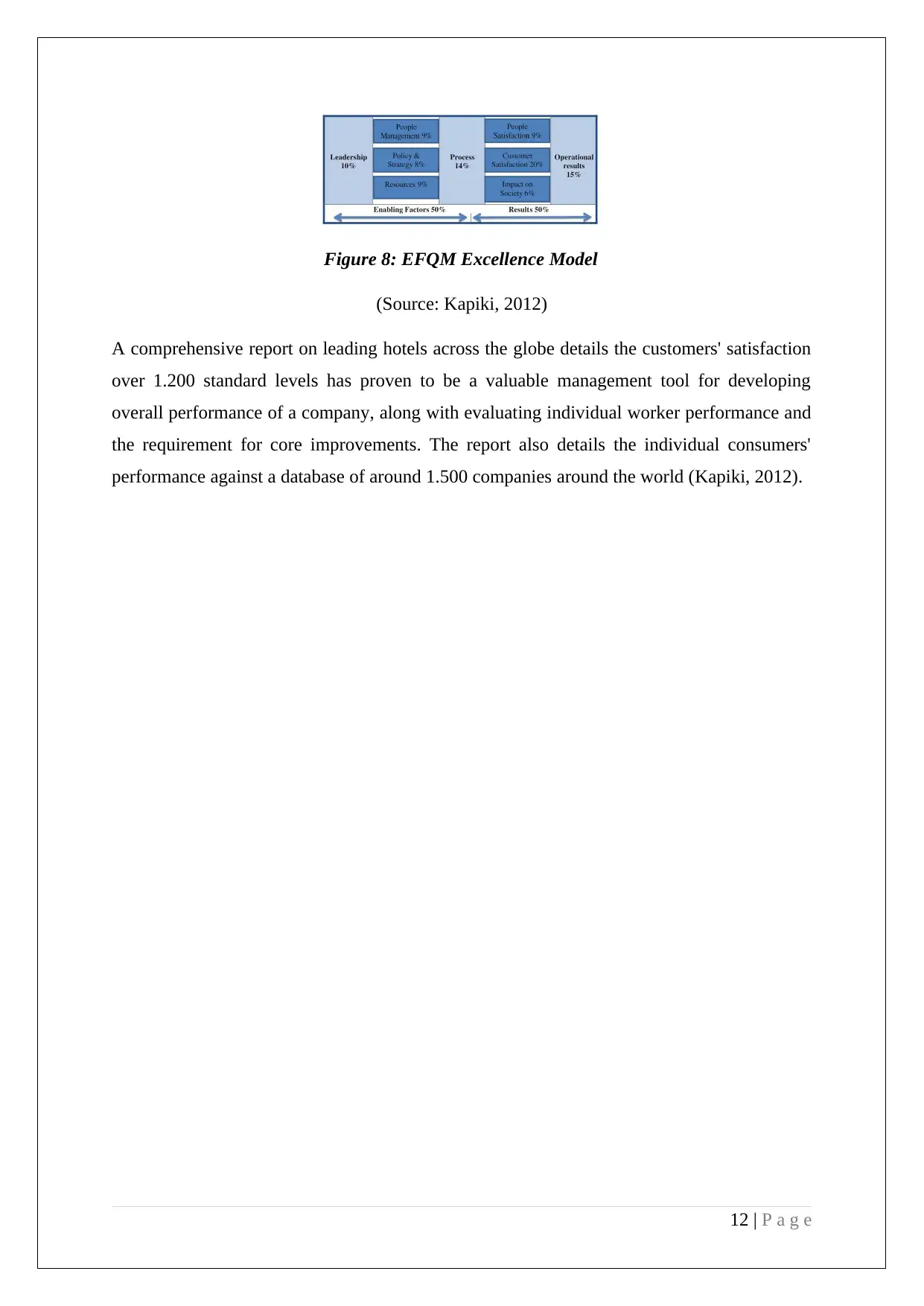
Figure 8: EFQM Excellence Model
(Source: Kapiki, 2012)
A comprehensive report on leading hotels across the globe details the customers' satisfaction
over 1.200 standard levels has proven to be a valuable management tool for developing
overall performance of a company, along with evaluating individual worker performance and
the requirement for core improvements. The report also details the individual consumers'
performance against a database of around 1.500 companies around the world (Kapiki, 2012).
12 | P a g e
(Source: Kapiki, 2012)
A comprehensive report on leading hotels across the globe details the customers' satisfaction
over 1.200 standard levels has proven to be a valuable management tool for developing
overall performance of a company, along with evaluating individual worker performance and
the requirement for core improvements. The report also details the individual consumers'
performance against a database of around 1.500 companies around the world (Kapiki, 2012).
12 | P a g e
⊘ This is a preview!⊘
Do you want full access?
Subscribe today to unlock all pages.

Trusted by 1+ million students worldwide
1 out of 19
Related Documents
Your All-in-One AI-Powered Toolkit for Academic Success.
+13062052269
info@desklib.com
Available 24*7 on WhatsApp / Email
![[object Object]](/_next/static/media/star-bottom.7253800d.svg)
Unlock your academic potential
Copyright © 2020–2025 A2Z Services. All Rights Reserved. Developed and managed by ZUCOL.





